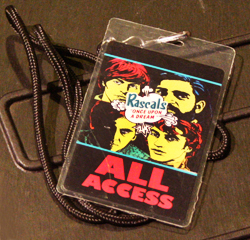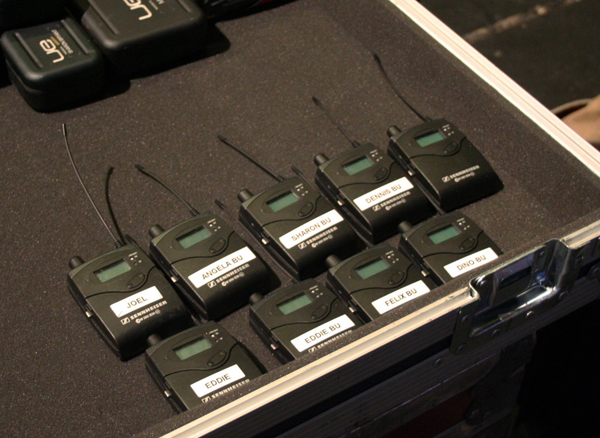
“This is not a simple monitor gig,” Hutchins states. “It’s taken some time to get them comfortable. We’re talking about musicians that haven’t been on ears their whole lives, they don’t want to be on ears. Gene looked at me the first week we worked together and said, ‘I want a monitor, I want a monitor.’ Eventually we got everybody happy.”
Musical director Prentice explains that the challenge of transitioning a band that used no vocal reinforcement beyond guitar amps to the highly devised performance environment they enjoy today was a seminal task. “In-ear monitoring is really the only way to do these shows.
Leaping from a zero monitor situation throughout their successful career to a potentially sterile laboratory environment with ears, and having to figure out how to get them feeling the music, and enjoying themselves and believing they are part of it, is the job and I think we’ve got there.”
A Matter Of Balance
After watching Hutchins mix a couple of tunes, and solo a couple of mixes, I learned that fundamentally, the primary issue is balancing Danelli’s drum kit, as the only non-isolated source onstage, with everything else. Hutchins hails from an extensive live television background, and was brought into rehearsals already underway when the band was not satisfied.
“I came in to observe what was going wrong, initially (under the guise of being) a video guy,” he notes. “The band wasn’t happy. It’s the old story of (balancing) a loud drummer and vocalists. I’m a drummer, and I wanted to get it right for Dino initially, so I spent a whole day playing his kit, with Brian Kingman (RF coordinator for the tour) mixing, to get the drum sound in Dino’s ears the way I thought he would like it. He came in the next day, sat down and played for 20 minutes by himself, and then looked at me and said, ‘that sounds fantastic.’ We had started to build some trust.
“Then it was a matter of understanding each of their ears,” he continues. “Gene (lead guitar) likes lots of top end, and Felix likes a midrange-scooped Steely Dan-type of sound. Very little low mids. Gene and Dino both have pretty aggressive rock mixes lots of kick and snare. Eddie doesn’t want to have any drums at all. He prefers to hear himself, some keyboard, and the background vocalists, leaning to a very unique, isolated blend of what is almost like folk music. Not like the other guys, but it works for him.”
Brigati is the lead singer of the Rascals and composer with Cavaliere of many of the group’s hit records. “Vocals, in my humble opinion, are supposed to be a glaze on the surface of the instruments,” Brigati states. “In rock and roll, you start with the bass drum and then build on that. I’m trying to get used to ears. You don’t hear the ambiance in the room in the same way (as) the earphones block out the ambiance in the room. An individual is feeding you a blend, but when it’s right, (IEM technology) helps me be a better singer.”
Hutchins describes the vocal treatments developed for the tour. “The only thing I’ve got going on gear-wise is two Avalon 737 compressors on Felix and Eddie’s vocals. We went through a lot of vocal mics initially, and settled on Telefunken M81s. Felix sounded best on a Neumann KMS 105, but it just brought in too much off-axis stuff to be practical.
“Eddie needs something with a lot of rejection, but also has crooner elegance to it. A full range mic that is warm and inviting. The M81 is a good compromise, they can work around it but it also has a tight pattern. Those Telefunken mics are pretty cool.”



